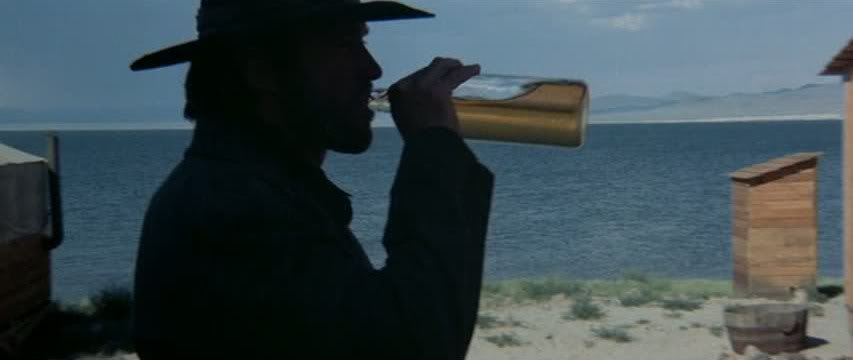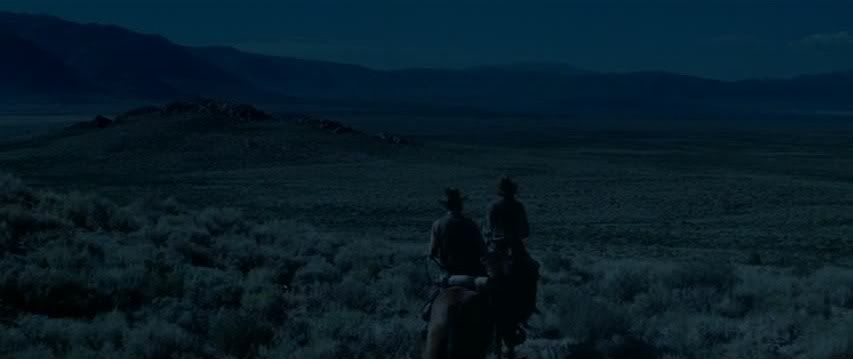
Clint Eastwood's High Plains Drifter is a rotten, ugly, disgusting movie, a descent into Hell in every way. It is a disturbing moral vacuum of a movie, a vision of complete societal breakdown that wallows in non-stop muck and grime for most of its running time. It doesn't start that way, though, as the opening sequence introduces Eastwood's unnamed drifter in a way that quite consciously recalls the spaghetti Westerns he made with Sergio Leone in the 60s, the films that established Eastwood as a Western icon. The opening is slow and methodical, as the drifter — he's credited as "the stranger," and remains one throughout the movie — rides over lush green countryside into the town of Lago, entering the town through a cemetery, the gravestones of which are highlighted in the foreground of the shot as the horse stomps between them, a staggeringly obvious premonition of what's to come. The setting itself is unique, a seaside town (shot in California) that surreally looks like a ramshackle Western way-station on the edge of a beach. The music sets the tone, too, an eerie whining drone that evokes Ennio Morricone's Leone soundtracks with more of a sinister edge; one isn't sure if a flying saucer is going to land or if a lot of people are simply about to die or, perhaps, if a ghost is riding into town.
Once the stranger enters the town, Eastwood puts the emphasis on the repetitive sounds of the town, as everyone simply stares silently as the rider passes by. There's no dialogue, only the rhythmic chuff, chuff, chuff of the horse's hooves kicking up dust on the dry road and then, when the stranger dismounts, the clang of his spurs and the hollow reverberation of his boots on the wooden planks of the saloon's front steps. After this evocative opening, which so thoroughly sets the scene and suggests that this film is a self-conscious response to Eastwood's spaghetti Western background, the film's story kicks into action and it becomes clear that, if this is a response to the spaghetti Western, it's strictly in negative terms. It's as though Eastwood set out not only to deconstruct his screen persona, but to drag it through the mud and totally destroy it, to tear it into shreds.
This stranger is recruited by the people of Lago to defend against a trio of outlaws who are returning to exact vengeance on the townspeople for sending them to jail, a familiar setup derived from multiple Western antecedents. Throughout the film, flashbacks and contrived dialogue scenes fill in the details of the town's past, suggesting that it's an utterly corrupt place with some very dark secrets. Eastwood's stranger appears to nudge this vile place a few steps closer to the abyss, acting as a kind of moral arbiter and judge of these disgusting, cowardly people, even though this stranger is equally monstrous. In particular, the film's attitude about rape is absolutely unforgivable and horrifying, as several scenes suggest that not just one but two women are forced into sex with Eastwood's character and wind up enjoying the rape and even in some ways actively pursuing the drifter. It's played, more or less, for laughs, as when one of the women returns to, quite understandably, take a few shots at the drifter for what he did. The stranger asks why it took her so long to get upset, to which the stranger's midget sidekick (Billy Curtis) replies that maybe she was just upset that he hadn't come back for more, which is a pretty appalling laugh line by any measure. Eastwood's character is portrayed as such a smirking badass that these women, though initially resistant, come to enjoy his attentions even when he forces himself on them. It's despicable, and makes it especially hard to take too seriously the film's moralist judgment of the other characters for their various hypocrisies and sins.

Indeed, by the end of the film the whole town has descended, quite literally, into Hell. Eastwood's drifter, using his position of power as their only defender to take control, reorganizes the town, orders all the buildings painted red, and paints over the town's name on the sign outside town with the inscription, "Hell." Yeah, it's not a very subtle movie. There's a kind of awful impact to many of the film's images, particularly when Eastwood exploits the slightly surreal setting of this beachside Western town. In one scene early on, Eastwood strides through the town and the camera tracks along with him, the bright blue of the sea shining through the glass whiskey bottle that the stranger is taking swigs from. Later, the town becomes truly hellish, with all those red buildings and flames everywhere, with the stranger himself as a kind of devil pronouncing his verdict on nearly everyone in the town. It's almost beautiful in its horrible way, especially when Eastwood's familiar silhouette is framed in black against the bright orange flames.
The film betrays a sadistic, nasty-minded sensibility, assaulting the audience with horrific images like a lengthy flashback (repeated several times) of a man being whipped to death in the center of the town. Each time the scene recurs, it goes on for an uncomfortable amount of time, with an emphasis on the sound of the whips thumping into flesh, while streaks of bright red movie blood run across the dying man's face and torso. The townspeople all look on, passively allowing this horror to happen, and Eastwood's aesthetic forces the audience into a similar passivity, forced to endure the sounds of the whips drawing blood for what seems like an endless span of time. Eastwood wants to rub the audience's faces in the violence, like a cinematic punishment, but he repeats the whipping sequence so many times, and lets it run for so long, that it goes beyond grating into simply boring.
Eastwood's character, though a sociopathic monster and a rapist, is the film's moral center, which says a lot about what a morally bankrupt movie this is. He's meant to be the voice of conscience who rides into town and exacts vengeance on these people who once stood by and watched while a man was killed. The revenge theme provides a justification for everything that happens subsequently, especially since the finale draws an explicit link between the unnamed drifter and the dead man, even suggesting, as the stranger fades away into a hazy mirage in the desert, that he's the reincarnation of the noble murdered man. The film keeps implying that, while what the stranger does is despicable, in some ways these people deserve what they get, that they were asking for it. That's precisely the film's attitude about rape, for sure, and what the stranger does to the town as a whole is akin to rape as well, the violation of the community as an entity. The stranger comes into town and rapes, not only the women, but the town as a whole, and the film suggests that maybe this is alright. The filmmaking frames most of the stranger's behavior as a big joke, with Eastwood's self-satisfied smirk as the rimshot following the punchline. Eastwood encourages the audience to laugh along with the stranger as he humiliates, punishes and torments the townspeople in revenge for their own horrible deeds.

6 comments:
It's a horror movie, doncha know? And as such, it succeeds.
So you really liked it, huh?
Here's a movie I haven't seen in years, remember nothing about it but "painting the town red", literally, and yet this review makes me want to see it again because it sounds so utterly morally corrupt. I'll check it out again soon and come back.
"a rotten, ugly, disgusting movie, a descent into Hell in every way. It is a disturbing moral vacuum of a movie, a vision of complete societal breakdown that wallows in non-stop muck and grime for most of its running time. "
IOW, My Kind of Movie!
While Play Misty For Me (mercilessly ripped-off by the perpetrators of Fatal Attraction) was a nice start, High Plains Dirfter showed Clint had real plans for a seriosu directorial career. Strictly speaking it's a variation on a varation : Clint seeing Leone via Kurosawa. Over and above all looms Dashiell Hammett's "Red Harvest" -- whcih bertolucii longed to film but never got off the ground despite years of trying.
Hah yeah, this one just really rubbed me the wrong way for some reason, even though as David says, if you gave me that description I'd probably say, "sounds great!" But I found the film very morally confused. It has some images and sequences that are compelling in their awful way, and Dean's characterization of it as a horror movie is pretty spot-on, but something about the directorial perspective on this material really put me off. Greg, I'll be curious to hear what you think if you revisit it.
Well of course it's morally confused. Clint is all about moral confusion. If you're plannign to work your way through Clint's oeuvre try The Gauntlet. Totally wiuld with a fabulous Jerry Goldsmith score that consists almost entirely of variations on "Just A Closer Walk Wiht Thee."
Hope y'all don't mind - I lifted one of the screengrabs for my own piece. Robin Wood greatly admired High Plains Drifter (believe it or not!), and I quote him here: http://alienatedinvancouver.blogspot.ca/2012/09/robin-wood-david-cronenberg-and-high.html
Post a Comment